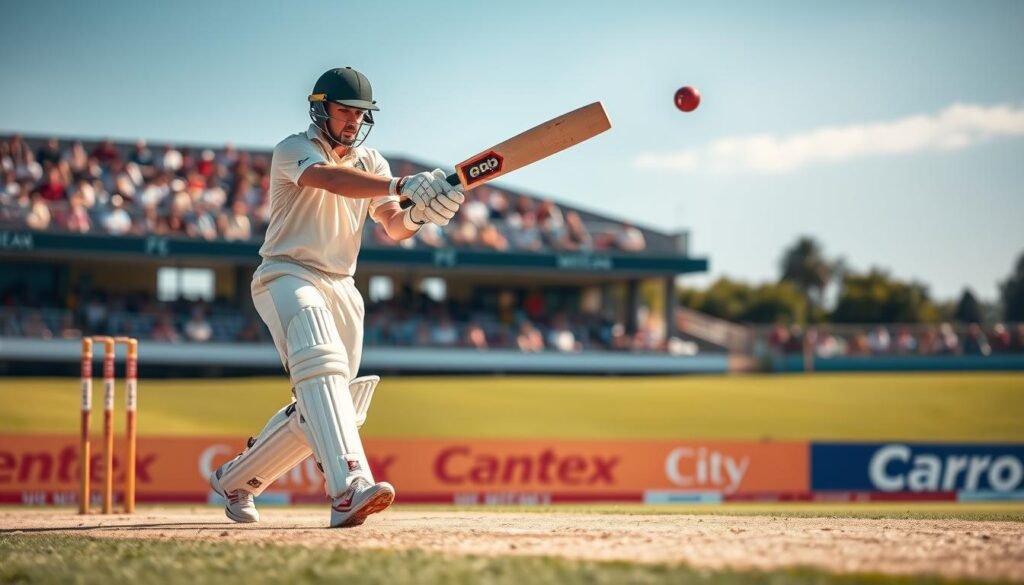The short ball is a tough challenge for batsmen in cricket. Learning how to play short balls can greatly boost a batter’s skill and confidence. It’s key to be able to read, react, and execute shots well against bouncers.
This article will look at the different techniques and strategies batsmen use to tackle short-pitched deliveries. It’s all about mastering the art of playing short balls.
Key Takeaways
- Mastering short ball techniques is crucial for improving batting skill and confidence.
- Understanding how to read, react, and execute shots against bouncers is essential for a well-rounded cricketing repertoire.
- This article explores the various techniques and strategies employed by batsmen to handle short-pitched deliveries.
- The short ball is a powerful weapon used by fast bowlers to unsettle and challenge batsmen.
- Developing an effective approach to playing short balls can lead to significant improvements in batting performance.
The Art of Playing Short Balls
Mastering the technique of playing short balls is key for any cricket batsman. Knowing how to react with quick footwork and body movement can save you from getting out. Let’s explore the details of this vital technique.
Identifying the Threat
The first step is to understand the characteristics of the delivery. Batsmen need to quickly spot the pace, length, and trajectory of the ball. This skill is about quick observation, experience, and making fast decisions.
Footwork and Body Movement
Good footwork and body movement help you position yourself right for the short ball. Moving your weight, adjusting your stance, and keeping your balance are key. These actions let you react with precision and power.
Getting better at playing short balls takes time and effort. It needs constant practice, sharp observation, and a deep understanding of the game. With the right mindset and strategy, batsmen can overcome this challenge and show off their skills.
Mastering the Pull Shot
The pull shot is a key technique in cricket. It helps batsmen score well against short-pitched balls. Learning the right technique and method is essential. This turns the pull shot into a valuable scoring skill.
Technique for Executing the Pull
Getting the pull shot right needs good weight transfer, body positioning, and bat movement. It’s important to time the shot well. This ensures you hit the ball at the best moment for maximum score and less chance of error.
- Start by shifting your weight onto your back foot as the ball comes in. This helps you build power for the shot.
- Stand with your shoulders and hips facing the bowler. This keeps you stable for the shot.
- Lower your bat in a smooth arc to hit the ball at the right height and position.
- Keep your eyes on the ball. This helps you hit it cleanly and with authority.
- Finish the shot by following through. Let your swing carry the ball to your target.
Practicing this technique regularly helps you become more confident and precise with the pull shot. It becomes a strong weapon in your batting arsenal.
“The pull shot is a great way to score runs and put pressure on the bowler. Mastering the technique takes time and practice, but it’s a skill that can make a real difference in your game.” – John Smith, Cricket Coach
The Hooked Stroke: A Risky Gambit

In cricket, the hooked stroke is a bold move for short-pitched balls. It can score runs and surprise bowlers. But, it’s risky, as a wrong move can lead to a big loss.
The technique involves moving weight to the back foot and swinging the bat hard. This shot needs great skill and judgment to hit it right. It’s about quickly spotting the short ball and hitting it well.
Though the hooked stroke is powerful, it should be used wisely. Batsmen must consider the pitch, bowler’s speed, and their own skills before trying it. Using it too much can lead to getting out quickly, losing its benefits.
“The hooked stroke is a double-edged sword – it can either make or break a batsman’s innings. The key is to know when to use it and when to exercise caution.”
The hooked stroke is a mix of boldness and control. Batsmen who use it well can score big. But, those who fail might lose a lot. Like any skill in cricket, mastering the hooked stroke takes practice and smart use.
Technique: The Key to Combating Bouncers

Mastering the technique of playing short-pitched deliveries is key for top cricket players. The technique a batsman uses can greatly affect their success against these challenging deliveries.
Pace and Wicket Conditions
The pace of the bowler and the conditions of the pitch are crucial. On fast, bouncy wickets, batsmen need an aggressive technique. They must be ready to hit the ball or ride the bounce.
On slower pitches, a defensive approach is better. The goal is to get the ball off the square without taking risks.
Aiming for the Throat
Aiming for the upper body, or the “throat,” is a top technique against bouncers. By hitting the ball as it rises, batsmen can deflect it and score. This technique needs great hand-eye coordination and timing.
| Technique | Pace | Wicket Conditions |
|---|---|---|
| Aggressive | Faster | Bouncier |
| Defensive | Slower | Flatter |
Understanding and adapting techniques for bouncers can greatly improve a batsman’s game. This knowledge and skill are vital for any cricketer aiming for the top.
Mental Preparation for Short Balls

Effective mental preparation is key for playing short balls in cricket. Batsmen need a mindset of controlled aggression. They should be ready to face the short ball but stay disciplined and in control.
It’s also important to manage thoughts that can harm performance. A strong mental approach helps cricketers use their technical skills better when facing short-pitched deliveries.
Controlled Aggression
Facing short-pitched deliveries is all about finding the right balance. Batsmen need to be aggressive but also restrained. They should show they can handle the short ball but do it with discipline and control.
This balance is crucial for beating the short ball threat.
Identifying Thought Patterns
In high-pressure moments, like facing many short balls, negative thoughts can creep in. Cricketers must be proactive in identifying these thoughts. They need to find ways to manage them well.
This could mean doing visualization exercises, using positive self-talk, or mental rehearsal. These help keep a confident and focused mindset when facing short-pitched deliveries.
By focusing on a strong mental approach, cricketers can improve their ability to handle short balls. Embracing controlled aggression and managing thoughts are vital for mastering the mental side of playing short-pitched deliveries.
Also Read : What Are The Basic Rules For Scoring Runs In A Cricket Test Match?
Conclusion
In cricket, learning to play short balls is key. Batsmen need to be good technically, tactically, and mentally strong. They must know how to move their feet and body to hit the ball well line especially way of doing something compile send us feedback expressed in the examples writer opinion dancer.
Playing shots like the pull and hook is important. This helps them deal with fast balls. A positive mindset and controlled aggression also help a lot.
With lots of practice, cricketers can get better. They become more confident and skilled. This makes them successful on the field.
The meaning of technique in cricket is deep. It’s not just about skill or ability. It’s about how to use strategies and tactics to win.
By mastering these techniques, cricketers stand out. They improve their game and succeed more often.
FAQs
Q: What is the definition of short balls in cricket?
A: Short balls in cricket refer to deliveries that bounce high and reach the batsman at around waist height, making them challenging to play effectively.
Q: Can you provide an example of a technique for playing short balls?
A: One effective technique for playing short balls is to adopt a back-foot position, allowing the batsman to pivot and pull or cut the ball away from the body.
Q: What are some common synonyms for the term ‘technique’ in the context of cricket?
A: In the context of cricket, common synonyms for ‘technique’ include ‘method’, ‘approach’, and ‘style’, which all refer to the manner in which a player executes their skills.
Q: What is the importance of mastering short ball techniques in cricket?
A: Mastering short ball techniques is crucial as it allows batsmen to effectively handle fast bowlers and take control of the game by scoring runs off challenging deliveries.
Q: How can players apply these techniques during a game?
A: Players can apply these techniques during a game by practicing their footwork, hand-eye coordination, and shot selection to better respond to short balls bowled by opponents.
Q: Are there any quizzes available to test knowledge on short ball techniques?
A: Yes, various online quizzes can help test your knowledge on short ball techniques, providing both educational and entertaining ways to enhance your understanding of the game.
Q: How do example sentences help in understanding the usage of the word ‘technique’?
A: Example sentences help clarify the usage of the word ‘technique’ by providing context, showing how it can be applied in sentences related to cricket and other fields.
Q: Where can I find the word history of ‘technique’ in a dictionary?
A: The word history of ‘technique’ can typically be found in the etymology section of a dictionary, which details its origins and how its usage has evolved over time.
Q: What type of content can be shared to improve skills in playing short balls?
A: Content such as instructional videos, articles, and expert tips can be shared to improve skills in playing short balls, providing insights from experienced players and coaches.
Q: What are the popular techniques for handling bouncers in cricket?
A: Popular techniques for handling bouncers include ducking under the ball, playing a defensive shot, or taking a step back to hook or pull, depending on the situation and the bowler’s speed.
